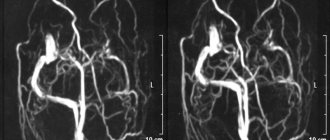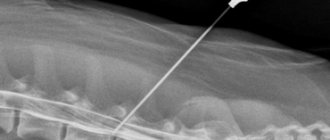Pregnancy and Phenazepam are incompatible, well almost...
During pregnancy, Phenazepam is prescribed extremely rarely.
Its use is advisable only if there is a threat to vital signs. The composition of the drug has a toxic effect on the fetus and increases the risk of having a child with congenital defects. The likelihood of pathology increases when taking Phenazepam in the early stages of pregnancy (first trimester).
In the third and last trimester, it is also dangerous to take Phenazepam, since it can cause depression of the central nervous system of a newborn baby, and if necessary, it is better to replace this drug with safer analogues.
If a woman takes the drug throughout her pregnancy, the baby develops a dependence syndrome. After the birth of a newborn, you will have to deal with the consequences of withdrawal. Young children have an immature central nervous system, which is sensitive to the suppressive effects of benzodiazepines.
Depressed breathing, decreased muscle tone, hypotension, hypothermia are possible consequences of taking Phenazepam in late pregnancy and just before childbirth.
What affects the dose of the drug?
If you read the instructions for the drug, you will understand why it is worth limiting the dosage of sleeping pills. It has a lot of negative side effects and contraindications, it is addictive and addictive. But what if the usual dose of phenazepam does not work?
Decide why this is happening.
1. Different people have different sensitivity to the drug.
Its effectiveness does not depend on body weight or age, it’s all about sensitivity to the active substance. Sometimes it happens that a person with insomnia is not affected by the dosage prescribed by the doctor. This is usually noticeable from the very beginning of treatment.
2. Over time, addiction develops.
Another situation: at first phenazepam helped, but then stopped. The body begins to require a larger dose of phenazepam in order to have any effect! When taking pills regularly, addiction inevitably occurs. The sensitivity of the receptors that perceive the drug decreases, and so does the effect of standard doses.
In exceptional cases they do prescribe - when?
The medicine has become widespread in the fight against diseases:
- syndrome that occurs due to alcohol withdrawal (abstinence);
- the presence of epileptic seizures or seizures of another nature in a pregnant woman;
- diagnosed psychiatric illnesses, such as schizophrenia;
- the presence of neurological diseases that caused severe irritation, anxiety or insomnia.
The drug is prescribed by a doctor, and the dose and course of treatment are selected depending on the patient’s condition. The drug can be administered intramuscularly or intravenously. Today, pharmacies also have the option of medicine in tablets.
Phenazepam was classified as a potent drug: its sale without a prescription will be criminally punishable
The drug will be issued according to an “enhanced prescription”. Doctors are increasingly saying that phenazepam is being abused. People who take it usually don’t talk about it, but there are a lot of them in Russia
Photo: Sergey Kiselev/AGN “Moscow”
Phenazepam is a Soviet-developed drug, a well-known and popular sedative. The active ingredient is benzodiazepine. Many note the hypnotic effect of phenazepam and, to be honest, it is often abused. The Ministry of Health is talking about the same thing.
The consequences of excessive consumption of phenazepam can be very disastrous, says psychiatrist-narcologist Alexey Kazantsev.
Alexey Kazantsev psychiatrist-narcologist “Phenazepam belongs to the group of benzodiazepines and is used for neurotic disorders and persistent sleep disturbances. But there are a lot of side effects: pronounced sedation with a hypnotic effect and a feeling of severe lethargy the next day; some say, a vegetable state sets in. That is, this type of drug requires strict indications, since it is addictive when taken for a long time - more than three weeks. And when drinking alcohol with the same phenazepam, a delirious change in consciousness quite often occurs, the so-called delirium tremens. That is, it has a lot of consequences.”
In a letter to the regions, the Ministry of Health explained that as of March 22, phenazepam is classified as a potent substance, and this immediately imposes a number of restrictions. Previously, phenazepam was sold in pharmacies according to a regular prescription, but now it is subject to subject-quantitative accounting. This means that a prescription for phenazepam will be collected from a pharmacy without fail and then stored for another three years; all transactions involving phenazepam will be recorded in a special journal - all so that addicted people cannot purchase the drug in several pharmacies. Neurologist Elena Kim continues:
Elena Kim neurologist “It has long been the case that phenazepam is a fairly popular drug in Russia, especially among the older generation. It was easy to buy and had a fairly quick effect. It can be replaced with new drugs. Buying it will naturally become more difficult. Even after the introduction of a new rule that we began to prescribe drugs according to simple prescriptions, it has become more difficult to purchase it, because previously it was purchased without a prescription at all. If they now replace it with a registration form, naturally, it will become more difficult, because pharmacies need a certain license to sell registered drugs.”
The transfer of phenazepam to the category of potent drugs does not mean that it will no longer be prescribed to those patients for whom it is vitally necessary. Prescriptions will still be issued for it, and it will also be able to be prescribed for inpatient treatment. In addition, phenazepam was not included in the list of narcotic and psychotropic drugs, which means that it does not fall under Article 228. However, a problem may arise with the availability of phenazepam: not everyone wants to take risks, and there are much fewer pharmacies selling drugs with subject-quantitative accounting than regular ones.
Add BFM.ru to your news sources?
But apparently in vain!
Phenazepam is quickly addictive. In order not to harm the patient, the dose is first gradually increased and then decreased. The course of treatment should not exceed two weeks, otherwise the risk of addiction increases.
The drug can cause a number of side effects; overdose and numerous side effects are possible, which must be taken into account when prescribing it to a pregnant woman.
The risk of allergies increases, manifested in the form of redness on the skin, severe itching and profuse rash. Phenazepam negatively affects the digestive system, resulting in vomiting, nausea, increased metabolism, yellowness of the skin, and abnormal bowel movements.
At the same time, the number of platelets, erythrocytes and leukocytes in the blood decreases. Cases of urinary incontinence or, conversely, delay in urine output have been recorded. The medicine can lead to hallucinations, severe drowsiness, visual disturbances and sudden changes in mood. A woman can suddenly move from depression to a euphoric state.
In this regard, we categorically do not recommend taking Phenazepam during pregnancy! As mentioned above, there are numerous analogues of the product that are safer and easier for pregnant women and their unborn child.
Expert opinion about this drug:
Phenazepam tab dispersible in the oral cavity 0.25 mg N 10
ATX Code:
N05BX (Other anxiolytics)
Active substance:
bromdihydrochlorphenylbenzodiazepine
Release form, packaging and composition of the drug
Tablets, dispersible in the oral cavity, white or almost white, round, flat-cylindrical, chamfered on both sides.
Bromodihydrochlorophenylbenzodiazepine - 0.25 mg
Excipients: betadex (beta-cyclodextrin), perlitol flash (mannitol and corn starch), magnesium stearate.
Clinical and pharmacological group:
Anxiolytic (tranquilizer)
Pharmacotherapeutic group:
Anxiolytic (tranquilizer)
pharmachologic effect
Anxiolytic drug (tranquilizer) of the benzodiazepine series. It has anxiolytic, sedative-hypnotic, anticonvulsant and central muscle relaxant effects.
Enhances the inhibitory effect of gamma-aminobutyric acid (GABA) on the transmission of nerve impulses. Stimulates benzodiazepine receptors located in the allosteric center of postsynaptic GABA receptors of the ascending activating reticular formation of the brain stem and interneurons of the lateral horns of the spinal cord; reduces the excitability of subcortical structures of the brain (limbic system, thalamus, hypothalamus), inhibits polysynaptic spinal reflexes. The anxiolytic effect is due to the influence on the amygdala complex of the limbic system and manifests itself in a decrease in emotional stress, easing anxiety, fear, and restlessness.
The sedative effect is due to the influence on the reticular formation of the brain stem and nonspecific nuclei of the thalamus and is manifested by a decrease in symptoms of neurotic origin (anxiety, fear).
The productive symptoms of psychotic origin (acute delusional, hallucinatory, affective disorders) are practically not affected; a decrease in affective tension and delusional disorders is rarely observed.
The hypnotic effect is associated with inhibition of the cells of the reticular formation of the brain stem. Reduces the impact of emotional, vegetative and motor stimuli that disrupt the mechanism of falling asleep.
The anticonvulsant effect is realized by enhancing presynaptic inhibition, suppresses the propagation of the convulsive impulse, but does not relieve the excited state of the focus.
The central muscle relaxant effect is due to inhibition of polysynaptic spinal afferent inhibitory pathways (to a lesser extent, monosynaptic ones). Direct inhibition of motor nerves and muscle function is also possible.
Pharmacokinetics
After oral administration, bromodihydrochlorophenylbenzodiazepine is well absorbed from the gastrointestinal tract, the time to reach maximum concentration in blood plasma (Tmax) is 1-2 hours. Metabolized in the liver. Half-life (T1/2) 6-18 hours. Excreted mainly by the kidneys in the form of metabolites.
Indications of the drug
- relief of attacks of anxiety, agitation, fear (including panic attacks, and other conditions accompanied by increased irritability, tension, emotional lability);
- neurotic, neurosis-like, psychopathic and psychopath-like states, reactive psychoses, autonomic dysfunctions, hypochondriacal-senestopathic syndrome (including those resistant to the action of other tranquilizers);
- sleep disorders;
- prevention of states of fear and emotional stress;
- as an adjuvant for the treatment of patients with temporal lobe and myoclonic epilepsy;
- increased muscle tone, hyperkinesis and tics, muscle rigidity with damage to the central nervous system;
- as part of complex therapy of alcohol withdrawal syndrome.
Dosage regimen
The drug is taken orally regardless of food intake. The tablet is taken immediately after it is removed from the package. The tablet should be kept on the tongue until it is completely dissolved and then swallowed without liquid.
In case of severe agitation, fear, anxiety attacks such as a panic attack (palpitations, fear, increased sweating, etc.), the drug is started with a dose of 1-2 mg, repeating, if necessary, 1 mg every 1.5 hours until the symptoms are completely relieved.
For the treatment of neurotic, psychopathic, neurosis-like and psychopath-like conditions, the initial dose is 0.5-1 mg 2-3 times a day. After 2-4 days, taking into account effectiveness and tolerability, the dose can be increased to 4-6 mg/day.
For sleep disorders - 0.25-0.5 mg 20-30 minutes before bedtime.
For the treatment of epilepsy – 2-10 mg/day.
For increased muscle tone, hyperkinesis and tics, muscle rigidity with damage to the central nervous system, the drug is prescribed at a dose of 2-3 mg 1-2 times a day.
For the treatment of alcohol withdrawal - orally, 2-5 mg/day.
A single dose is usually 0.5-1 mg. The average daily dose is 1.5-5 mg, divided into 2-3 doses, usually 0.5-1 mg in the morning and afternoon and up to 2.5 mg at night. The maximum daily dose is 10 mg.
To avoid the development of drug dependence during a course of treatment, the duration of use of the drug Phenazepam® is 2 weeks (in some cases, the duration of treatment can be increased to 2 months). When discontinuing the drug Phenazepam®, the dose is reduced gradually.
Side effect
From the hematopoietic system: leukopenia, neutropenia, agranulocytosis (chills, hyperthermia, sore throat, excessive fatigue or weakness), anemia, thrombocytopenia.
From the nervous system: at the beginning of treatment (especially in elderly patients) - drowsiness, fatigue, dizziness, decreased ability to concentrate, ataxia, disorientation, gait instability, slowed mental and motor reactions, confusion, headache, tremor, decreased memory, impaired coordination of movements (especially when used in high doses), dystonic extrapyramidal reactions (uncontrolled movements, including the eyes), asthenia, myasthenia gravis, dysarthria, epileptic seizures (in patients with epilepsy), paradoxical reactions (aggressive outbursts, psychomotor agitation, fear, suicidality, muscle spasms, hallucinations, agitation, irritability, anxiety, insomnia).
Mental disorders: euphoria, depression, depressed mood, addiction, drug dependence.
From the side of the organ of vision: visual impairment (diplopia).
From the cardiovascular system: decreased blood pressure, tachycardia.
From the gastrointestinal tract: dry mouth or drooling, heartburn, nausea, vomiting, loss of appetite, constipation or diarrhea.
From the liver and biliary tract: liver dysfunction, increased activity of ALT, AST and alkaline phosphatase, jaundice.
From the urinary system: urinary incontinence, urinary retention, renal dysfunction.
From the genital organs and mammary gland: decreased or increased libido, dysmenorrhea.
From the skin and subcutaneous tissues: skin rash, itching.
General disorders: weight loss.
With a sharp reduction in dose or discontinuation of use - “flaccid baby” syndrome).
The use of Phenazepam® during breastfeeding is contraindicated. Breastfeeding should be stopped during treatment.
Use for liver dysfunction
The drug should be used with caution in case of liver failure.
Use for renal impairment
The drug should be used with caution in case of renal failure.
Use in children
The use of the drug is contraindicated in children and adolescents under 18 years of age (the safety and effectiveness of the drug have not been determined).
Use in elderly patients
The drug should be used with caution in elderly patients.
special instructions
When using, dispersible tablets should only be handled with dry hands.
In case of renal and/or liver failure and long-term treatment, it is necessary to monitor the peripheral blood picture and the activity of liver enzymes.
Patients who have not previously taken psychoactive drugs exhibit a therapeutic response to the use of Phenazepam in lower doses compared to patients taking antidepressants, anxiolytics, or those suffering from alcoholism.
Like other benzodiazepines, it has the ability to cause drug dependence when taken for a long time (more than 2 weeks) in high doses (more than 4 mg/day).
If you suddenly stop taking it, withdrawal symptoms may occur (including depression, irritability, insomnia, increased sweating), especially with long-term use (more than 8-12 weeks).
Particular caution is required when prescribing the drug for depression, because the drug can be used to realize suicidal intentions.
If patients experience unusual reactions such as increased aggressiveness, acute states of agitation, feelings of fear, thoughts of suicide, hallucinations, increased muscle cramps, difficulty falling asleep, shallow sleep, treatment should be discontinued.
During treatment, patients are strictly prohibited from consuming ethanol.
Use in pediatrics
The effectiveness and safety of the drug in patients under 18 years of age have not been established.
Impact on the ability to drive vehicles and operate machinery
During the treatment period, it is prohibited to drive vehicles or engage in other potentially hazardous activities that require increased concentration and speed of psychomotor reactions.
Overdose
Symptoms: severe depression of consciousness, cardiovascular and respiratory activity, severe drowsiness, prolonged confusion, decreased reflexes, prolonged dysarthria, nystagmus, tremor, bradycardia, shortness of breath or difficulty breathing, decreased blood pressure, coma.
Treatment: gastric lavage, taking activated charcoal, monitoring vital body functions, maintaining respiratory and cardiovascular activity, symptomatic therapy. Hemodialysis is ineffective. Specific antagonist: flumazenil (in a hospital setting) – 0.2 mg intravenously (up to 1 mg if necessary) in a 5% glucose solution or 0.9% sodium chloride solution.
Drug interactions
When used simultaneously, Phenazepam reduces the effectiveness of levodopa in patients with parkinsonism.
Phenazepam may increase the toxicity of zidovudine.
There is a mutual enhancement of the effect with the simultaneous use of antipsychotic, antiepileptic or hypnotics, as well as central muscle relaxants, narcotic analgesics, ethanol.
Microsomal oxidation inhibitors increase the risk of toxic effects. Inducers of microsomal liver enzymes reduce effectiveness.
Phenazepam increases the concentration of imipramine in the blood serum.
When used simultaneously with antihypertensive drugs, the hypotensive effect may be enhanced.
Increased respiratory depression may occur during co-administration with clozapine.
Emergency or caesarean section to be delivered
On the recommendation of the anesthesiologist, depending on the health and emotional state of the woman, Phenazepam is prescribed before the CS. As prescribed, it should be administered the night or immediately before surgery.
Pre-medication is often used as a relaxation before general anesthesia. Thanks to taking the drug, a woman’s anxiety and gland secretion are reduced.
Also, after the medicine, the effect of drugs used for anesthesia is enhanced. In this case, the combination of drugs may be different. It includes analgesics, sedatives and antihistamines.
Survey of women in labor
We checked a survey of women in labor who took Phenazepam during pregnancy, and here are their reviews.
I was prescribed one Phenazepam tablet the night before my upcoming planned Caesarean section. The fact is that I was very worried and worried about the outcome of the upcoming operation.
I asked my husband to read reviews about the drug on the Internet. They were quite contradictory, however, the purpose of the appointment (keeping calm and healthy sleep) made me agree to the appointment. Sleep came in about 20 minutes.
I slept well all night and woke up fresh and rested in the morning. Operation was successfully completed. A daughter was born (9 out of 10 on the Apgar scale). After anesthesia, I recovered quickly and easily. In my case, the drug deserves only positive reviews.
Victoria, 28 years old
Considering my age and great desire to have a second child, I had to be in confinement 4 times during the entire pregnancy. The fact is that 1.5 years before that I lost my baby at an impressive age. For me, every move, pill, and prescription mattered.
Now I understand that I took everything to heart. I should add that I have problems with blood pressure and excess weight, so my second pregnancy was a challenge for me.
Lying on guard in the same ward with a woman much younger than me in age, I had to see how she lost her baby. At that moment I literally experienced shock. She was much younger and healthier than me. I started getting hysterical. As doctors later explained, the risk of fetal loss has increased.
In order to calm me down, they injected me with Phenazepam. Later I found out that during pregnancy it is used extremely rarely. The drug helped, I quickly calmed down and slept. Subsequently, I gave birth to a healthy girl, however, and today I believe that you should not drink anything stronger than valerian during pregnancy.
Valentina, 40 years old
phenazepam and pregnancy
Hello my dear! I haven’t written for a long time, the Internet didn’t work. We were born on August 20, 2013. The birth was difficult, she gave birth by emergency caesarean section. Girls, almost two months have passed, so now I’m happy and have forgotten everything. But what happened to me before giving birth... As luck would have it, two weeks before the expected day of giving birth, my Internet stopped working, and I couldn’t ask anyone for advice. I'll tell you how it all began. My gynecologist put the PDD on 08/15/2013, and in my dispensary book - on 08/10/2013. I roughly knew that I would give birth between 08/10/2013 and 08/23/2013. My gynecologist said that if 15 I’m not giving birth - come on the 16th for a referral to the pathology department of the maternity hospital. The maternity hospital where I wanted to give birth closed, as luck would have it, in August for cleaning and disinfection. There is only one maternity hospital left in Tula. It was also possible to go to give birth in Shchekino. But I still decided to give birth closer to home (probably in vain). In general, on the evening of the 16th, my gynecologist (she worked the second shift) gave me a referral to go to the pathology department of the Tula maternity hospital. Because August 17 and 18 were days off, I thought I would go to the hospital on the 19th (Monday). But... On the 17th, in the late afternoon, my lower back started to hurt very badly, and at night I felt like something was grabbing my lower back and letting go. It gave me discomfort and fear of the unknown, “what is this? contractions? I didn't sleep that night. In the morning, my husband and I decided to go with a referral to the maternity hospital (even though it was Sunday, there should be a doctor on duty), and we went. I wasn’t afraid, we were driving in a good mood (it’s our wedding anniversary on the 18th, my husband gave me a bouquet of flowers in the morning, and we also thought it would be great to give birth on our anniversary). But it was not there. The reception I received was simply disgusting. The doctor examined me and said that I definitely wouldn’t give birth today, my cervix was hard, and the birth canal was not ready. I say, the gynecologist referred me to your pathology department, I’m already 41 weeks old (according to my calculations, it was forty), I’m scared to sit at home, especially since the gynecologist has already sent me, and my lower back hurts. To which the doctor angrily replied that she would definitely not admit me today. I say that tomorrow then I’ll come to bed, to which the answer was given that it’s possible that they won’t be able to go to bed tomorrow either, because... there are no seats. And all this with such anger. And the woman who was in the waiting room basically yelled that you had arrived, you were having false contractions, they could last for two weeks. As a result, we left, such a residue was left from visiting this maternity hospital, I began to fear how I would even give birth here, I am most afraid that they will yell at me during childbirth. And so all day and all night my lower back continued to hurt, at night even worse, and again I did not sleep. At 5 o'clock in the morning we went again to this maternity hospital. They greeted me there even worse, with the following complaints: why have you arrived again, so early, is there nothing else to do, everything is exactly the same with you as yesterday, nothing has changed, you definitely won’t give birth today. I say that my lower back hurts, and the light discharge in the morning was strong, flowing straight down my legs, to which I was told that I was having false contractions, and the discharge was a plug coming off like that, and it could go away for three days. Yeah... At the same time they looked at me like I was a fool. I was so upset. I am asking whether they will admit me with a referral to pathology or not, because... I'm scared to sit at home. They got mad and told me to undress and brought me a transparent shirt. I ask what is this? She answers me, like what, you wanted to give birth, they tell you that you won’t give birth today, but you still came, well, go and watch how women give birth (she said this with such mockery, I felt so offended, I burst into tears, She said that she needed to talk to her husband). I came out to him all in tears. In the prenatal room we heard such screams, my husband and I were in shock: “Help, save me, Lord, it hurts, put me to sleep!” Girls, you can’t imagine how scared I was after all this. My husband said to stay, what else to do, I still have to give birth. I tell him how I was met at the reception, and we already wanted to pick up the documents to go to the Shchekino maternity hospital (why didn’t we do this, after all, my husband’s dad knows a doctor there, I still don’t know what dissuaded us from this? ). The husband swore at the woman who was in the waiting room and asked why they were treating a pregnant woman this way, why were they behaving so rudely? She answered, we are not being rude, we just arrived early, and we are also complaining about contractions, but they are false. As a result, I stayed there, they gave me an enema, put on a robe and took me to the prenatal room. There was horror there...... 8 beds, women scream terribly, especially one so loudly, and they shout at her that she gets up (they don’t allow you to get up at all, only to go to the toilet, and even then they very rarely let you go, you have to ask long and hard). I was lying there, and suddenly I was the only one screaming (she was struggling), I turned around, to which they yelled at me that I had come here to look at women? I’m not giving birth, which means I must lie quietly, there was no point in complaining (they said it with such anger and mockery). After four hours in the prenatal room, I asked to be transferred to pathology. They ask me: what, everything has already passed, I said yes, because... I understand that I can no longer be here, although my lower back still hurts. Two hours later I was sent to pathology. There they took all the documents, got a card, I breathed a sigh of relief that at least I could rest here now, because... My psyche has already been damaged today, and the fear began that I wouldn’t be able to give birth, that everything was going wrong, that everyone was yelling at me, I definitely wouldn’t give birth, I started getting hysterical. Then they showed me the room where they put me. Everything seemed fine, I made the bed, they gave me a normal robe (and I walked around with my head in a transparent prenatal robe). I really liked the woman in the dining room, she brought me a robe and a nightie, showed me everything, where the toilet was, where the dining room was, I was so grateful to her. Honestly, I no longer expected to meet a person who would treat me normally. Before I could lay down on the bed, I was called for an ultrasound. After the ultrasound I asked if everything was fine with me, she answered yes. I went to my room. I just came in again and they called me in for an examination. The doctor was watching and the nurse was standing next to her. The doctor asked something, I didn’t understand, and the nurse asked me again: how long do you think you have? I answer that 40 weeks. The doctor tells me, actually, I’m asking you, and it’s me who needs to answer, not the nurse. I say, okay. Then she suddenly pulled something “there” at me, it hurt very much, my tears started flowing. She’ll start telling me that you’re like a little girl, breathe when it hurts, tomorrow we’ll stimulate you, you have first-degree pelvic contraction, oligohydramnios, but you’ll give birth on your own, the baby is small. Girls, after that I burst into tears, I had thoughts in my head that I wouldn’t give birth at all, that I wouldn’t see my baby, honestly, I probably went crazy at that moment, I was in such a state that I thought I wouldn’t give birth that I couldn’t do it, everyone was yelling at me, I wanted to leave the maternity hospital with such an attitude. I called my mother in tears, told how they were shouting at me, I couldn’t calm down. At that time, I probably needed a psychologist. Moreover, no one talked about a narrow pelvis during pregnancy. I WAS VERY ILL. When I went to the toilet, I saw blood. The nurse said it was because they were looking at me in the chair. In the evening, my husband brought me things, I sat with him and cried, I didn’t know what to do, that I was afraid of stimulation and in general why they told me that I had a narrow pelvis, why did I go to this prenatal room, to scare me about childbirth? My tears did not stop. My husband went to talk to the doctor to reassure us and tell us that everything would be fine. The doctor said that she would look at me in the evening, my husband said that he would thank me, as long as everything was fine. After lights out, at about 10 pm, a doctor came to see me, with whom my husband was talking. The nurse called, gave me a signature to consent to induce labor the next day, and gave me two tablets of valerian and phenazepam. The doctor looked at the chair and said that the cervix was very hard, the baby weighed small: 3100-3200, she should give birth on her own. I say that I was told that I have a narrow pelvis, the nurse replies: nothing, look at how big the stretch marks are on your hips, and I’m still a woman, don’t be afraid. I’ll tell the doctor, maybe I should get some painkillers or even a cesarean section, then I won’t be able to give birth. She says I can do anything. I went out to my husband and told me to complain about the pain and then I would give birth to her tonight, she would give me pain relief, and she would monitor me, and if anything went wrong, I would have a caesarean section. I complained to the nurse about the pain, the nurse told me not to be like a little girl, to take pills and go to bed. But I said that I’m going to give birth today, I won’t be able to wait until tomorrow, I won’t sleep and I won’t have the strength. As a result, she furiously took me for an enema. She didn’t allow me to take the phone, just water and took me downstairs to the prenatal area. There was the same nurse there who looked at me in the morning and said, well, she came today after all, and now we have to bother with you. The baby doesn’t want to appear yet, but she keeps rushing him, I say that tomorrow they will still stimulate him, and that this way I can walk until 45 weeks, and she says: well, what’s the problem, go. I no longer paid attention to her words. The doctor punctured my bladder and said that the water was really low. Then they injected me into a vein and contractions began. The time was approximately 23.15. My doctor went in for surgery and said she had 9 of them. At this time I was observed by another doctor. I looked at the dilatation of the cervix. When I looked, I said that the dilation was 4 cm. The nurse told me to give me an epidural (honestly, I don’t really understand what it is, they gave me an injection into a vein and my mouth felt warm, it seemed like a painkiller). I don’t know if this numbed me or not, but the contractions continued to intensify. The time was approximately 4.35, my doctor was free. My contractions were a minute apart. The doctor examined me and said that my cervix was still in the same condition, and asked me: well, are we going to tear it during childbirth? I do not understand anything. She says we will do Caesarean. I agreed. And they took…………. I didn’t care anymore, as long as they got the baby as soon as possible so that everything would be fine with him. There were strong contractions, almost constant. The anesthesia was administered in the back, so it was scary that I would twitch at that moment, it’s good that the woman who was with the anesthesiologist was holding me. They gave me an injection, and a warmth went down my legs, and it felt so good... At this time they were giving me some kind of IV, they put a screen in, I looked at the clock. After 15-20 minutes they took out my daughter and showed it to me. I was so happy, I just couldn’t believe my eyes, thank God, I said to myself, I couldn’t believe that everything would be fine. They let me touch her hand and took her away. In general, then everything was fine. Thank God we are alive and well. We were discharged on the seventh day. Now we are at home, happy. Girls, caesarean is not terrible either. I read so many negative reviews. But what can you do if sometimes it doesn’t turn out the way you thought. My cervix did not dilate, they wrote that labor was weak. Of course, when I left the hospital, I replayed that day of birth, thinking that everything could probably have been different, that I could have given birth myself if they had prepared my cervix for childbirth, softened it. But... everything turned out the way it turned out. My stitch hurt for the first two days, then I put on a bandage and it didn’t hurt at all. We were born 3100 kg, 51 cm, 8/8 Apgar. We are growing little by little, making our parents happy, and we are the happiest parents in the world!!!
PS of course, I am shocked by this maternity hospital, such a terrible attitude towards women in labor. In the postpartum department there was also horror, which I can write about endlessly, but here are some points: during the 6 days of my stay there, I changed 4 wards, that is, they put me in one ward, everyone was discharged, but I was not, they were put in another, everyone was discharged, and I’m not there, and so on 4 times. Once they helped me drag things, all the other times I dragged them myself, and this was after a caesarean section, when you can’t carry heavy things, and there were a lot of packages. The phone was brought from the pathology only a day after the birth, the relatives were going crazy all this time. There is only one nurse, such a fool, she really infuriated me, she gave me one instead of three injections, and when I asked her that I would no longer be given injections, only one, she replied, to whom should I explain myself? And when he tugged me from behind by the patch where the spinal anesthesia was, I jumped out of surprise, and the seam hurt so much, bitch, I can’t find any more words. No one showed how to swaddle or apply to the breast, we were left to our own devices. And, of course, the “Mother and Child” program is good, the child is always with you, but after a caesarean section it’s really hard to get up, and then you have to swaddle the child, change diapers, that is, be constantly with him, not go anywhere, it’s very difficult . But all's well that ends well. Six days were like a month to me. At night, when we were discharged, I passed out, my husband said that I snored like a locomotive. :)
Conclusions and facts
The sedative drug Phenazepam should be taken with caution in all patients. To do this, you should first obtain a doctor’s prescription and under no circumstances begin treatment on your own.
During pregnancy, the drug is prescribed only if absolutely necessary and there is a threat to the life of the child or mother.
Before a planned CS, Phenazepam is used as a preparatory drug that helps a woman relax and not be in a state of anxiety before the upcoming operation.
The prescription is made depending on the psycho-emotional state of the woman and is authorized by the anesthesiologist.









